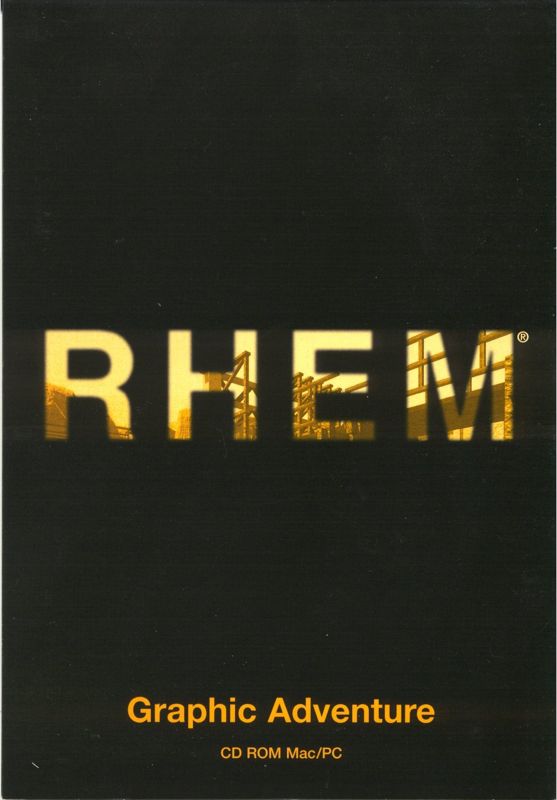Retro Replay Review
Gameplay
Stepping into Rhem feels like embarking on an old-school, first-person point-and-click adventure, evoking memories of classics such as Riven. You begin your journey in a mining cart, traversing narrow tracks into an expansive and peculiar world. Immediately upon arrival, you discover the exit is sealed, and your sole mission becomes finding a way out. There are no NPCs or companions to guide you—everything hinges on your wits, patience, and perseverance.
(HEY YOU!! We hope you enjoy! We try not to run ads. So basically, this is a very expensive hobby running this site. Please consider joining us for updates, forums, and more. Network w/ us to make some cash or friends while retro gaming, and you can win some free retro games for posting. Okay, carry on 👍)
The heart of Rhem’s gameplay lies in its intricately designed puzzles. Early on, many areas are locked or inaccessible, compelling you to explore every nook and cranny for clues. Mechanical contraptions featuring levers, gears, and switches abound, each subtly connected to hidden doors or secret compartments. Beyond these physical mechanisms, you’ll encounter cryptic codes, mysterious maps, and arrays of symbols that demand careful note-taking and logical deduction.
Progressing through Rhem is a satisfying back-and-forth between observation and experimentation. You might spot a color pattern etched into a wall, only to realize later that it corresponds to a switch box in a distant chamber. Patience is rewarded—each breakthrough, whether you finally decode a numeric sequence or unlock a long-sealed door, instills a genuine sense of accomplishment. This cerebral focus is ideal for players who relish methodical problem-solving over reflex-driven action.
Graphics
Rhem’s visual presentation leans heavily on pre-rendered environments, delivering richly detailed scenes that feel both alien and ancient. Stone corridors carved with unfamiliar glyphs, rusted metal panels, and subtle lighting nuances combine to create an atmosphere of quiet mystery. Although the graphics reflect the era of its release, the aesthetic choices age well, immersing you in a world that appears lived-in yet otherworldly.
Textures are crisp enough to discern fine details—cracks in the rock walls, mechanical joints on levers, and weathered markings on doors. The muted color palette reinforces the game’s enigmatic mood; browns, grays, and occasional splashes of color draw your attention to puzzle elements. There are no flashy particle effects or dynamic shadows, but deliberate use of light and dark zones heightens suspense as you navigate dimly lit passages.
Camera angles are fixed at specific viewpoints, a common design choice in classic adventure titles. While this can occasionally feel restrictive, it also allows the developer to frame each puzzle area meticulously. Zooming into objects reveals hidden dials or symbols, and subtle audio cues accompany interactive hotspots. Overall, Rhem’s graphics excel at setting a tone of discovery and intrigue, even if the technical fidelity isn’t on par with modern 3D engines.
Story
Rhem’s narrative unfolds through its environment rather than through dialogue or cutscenes. You learn about the world by uncovering fragments of a divided letter—your only tangible link to what transpired here. Reconstructing this letter, split into four hidden pieces, becomes the overarching goal driving your exploration. The absence of other characters lends an eerie solitude to your quest.
Subtle storytelling emerges from the architecture and scattered clues. Elaborate corridors hint at a once-thriving society skilled in engineering and symbolism. Yet, there are no bodies or explicit lore texts to explain what happened to the inhabitants. Instead, you piece together the backstory through inscriptions, diagrams, and the very design of the puzzles, which feel purposeful rather than arbitrary.
The minimalist approach to narrative fosters a sense of personal investment. You become the narrator of your own adventure, interpreting every etched symbol or strange device as a chapter in Rhem’s unwritten history. This form of environmental storytelling rewards players who appreciate discovery over exposition and encourages replaying sections to catch previously overlooked details.
Overall Experience
Rhem is a trial of intellect and observation that doesn’t hold your hand. If you’re seeking fast-paced action or character-driven drama, you may find its solitary, puzzle-centric design challenging. However, for aficionados of cerebral adventures, Rhem offers a deeply fulfilling journey where every solved enigma delivers genuine satisfaction. Be prepared to take notes and backtrack often—this is a game that rewards methodical exploration.
The pacing is deliberately measured, with tension building as you encounter increasingly complex mechanisms. There are moments of frustration, particularly when clues are obscured or puzzles require leaps of logic. Yet overcoming these hurdles is part of Rhem’s enduring charm. The game’s low-key soundtrack and sparse sound effects further enhance immersion, allowing you to concentrate fully on the riddles before you.
Ultimately, Rhem stands as a testament to classic adventure design, delivering an experience that remains engaging decades after its release. Its strengths lie in smart puzzle integration, atmospheric world-building, and an open-ended narrative that invites interpretation. If you delight in unraveling mysteries at your own pace and appreciate the art of meticulous puzzle crafting, Rhem is a journey well worth undertaking.
 Retro Replay Retro Replay gaming reviews, news, emulation, geek stuff and more!
Retro Replay Retro Replay gaming reviews, news, emulation, geek stuff and more!




Reviews
There are no reviews yet.